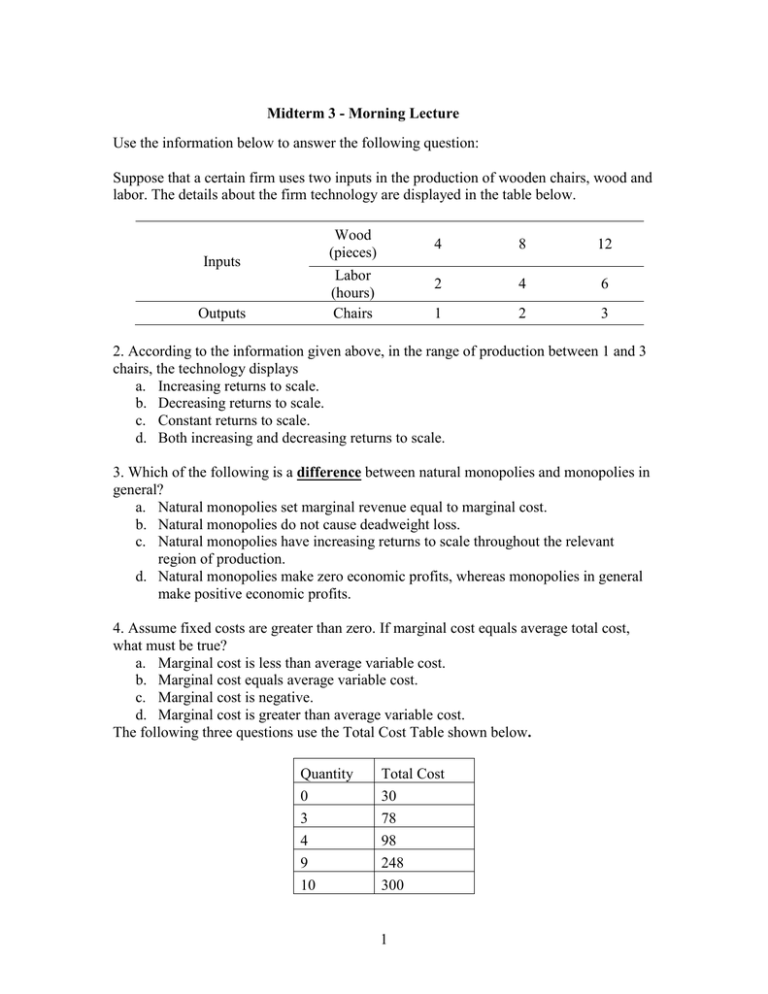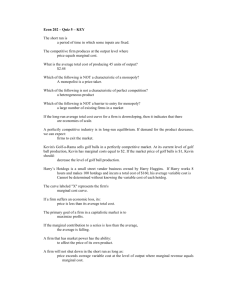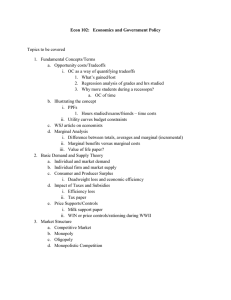Use the information below to answer the following question:
advertisement

Midterm 3 - Morning Lecture Use the information below to answer the following question: Suppose that a certain firm uses two inputs in the production of wooden chairs, wood and labor. The details about the firm technology are displayed in the table below. Inputs Outputs Wood (pieces) Labor (hours) Chairs 4 8 12 2 4 6 1 2 3 2. According to the information given above, in the range of production between 1 and 3 chairs, the technology displays a. Increasing returns to scale. b. Decreasing returns to scale. c. Constant returns to scale. d. Both increasing and decreasing returns to scale. 3. Which of the following is a difference between natural monopolies and monopolies in general? a. Natural monopolies set marginal revenue equal to marginal cost. b. Natural monopolies do not cause deadweight loss. c. Natural monopolies have increasing returns to scale throughout the relevant region of production. d. Natural monopolies make zero economic profits, whereas monopolies in general make positive economic profits. 4. Assume fixed costs are greater than zero. If marginal cost equals average total cost, what must be true? a. Marginal cost is less than average variable cost. b. Marginal cost equals average variable cost. c. Marginal cost is negative. d. Marginal cost is greater than average variable cost. The following three questions use the Total Cost Table shown below. Quantity 0 3 4 9 10 Total Cost 30 78 98 248 300 1 5. What is the marginal cost of one additional unit when the firm is currently producing 3 units? a. $20 b. $16 c. $20/3 d. $26 6. At which of the following quantities is the difference between the average total cost and average variable cost smallest? a. 9 b. 4 c. 10 d. 3 7. If fixed costs decreased by $10 for the firm shown in the table above, the marginal cost of one additional unit when the firm is initially producing a quantity of 3 will a. Stay the same. b. Decrease. c. Increase. d. Be uncertain since there is not enough information given to answer this question. 8. Suppose one unit of labor costs $10/hr and the fixed costs for a firm are $6/hr. If one worker can produce 4 items/hr, what is the average total cost for the firm when 12 items are produced in an hour? a. $3 b. $36 c. $5/3 d. $1/2 Use the following information to answer the next two questions. Suppose that in the market for cigars, MC=2q, where q is the quantity produced by the representative firm. Furthermore assume that this market is perfectly competitive and that the prevailing price on this market is $10. 9. What is the profit maximizing quantity of output that each firm will choose to produce? a. 20 b. 10 c. 5 d. 0 2 10. Suppose that ATC reaches $10 at its minimum point and the demand for cigars in this market is perfectly inelastic at 2000. What is the equilibrium amount of firms that this market can support in the long run? a. 1000 b. 400 c. 200 d. 100 Please use the following table to answer the next two questions. The cost schedule below is for firm XYZ, which produces DVD players. DVD players 0 1 2 3 4 Marginal Cost 0 25 50 75 100 Fixed Cost 50 50 50 50 50 11. What is the total cost for producing 4 DVD players? a. $400 b. $500 c. $250 d. $300 12. What is the average variable cost for producing 3 DVD players? a. $25 b. $37.5 c. $50 d. $ 62.5 13. As output increases, which of the following costs would never increase in the short run? a. Total Costs b. Average Total Costs c. Marginal Costs d. Average Fixed Costs The following figure represents a company’s situation. Use the figure below to answer the following two questions. 3 Price or Cost per unit ($) Marginal Cost Average Total Cost Price=$22 Average Variable Cost Q=Output 14. The president of this company hires 4 consultants. Which consultant’s statement is correct? (consider only the Short Run!) a. Consultant A: This business is operating with a “Loss”, and it should stop producing goods immediately. b. Consultant B: This business is operating with a “Loss”, but it should continue to produce goods. c. Consultant C: This business is operating with an “Economic Profit”, so it should enjoy its positive profit. Congratulations!! d. Consultant D: In order to increase profits, you should adjust the amount you spend on sunk costs. 15. Based on the above graph, in the long run: a. More firms will enter this industry, which will lead to an increase in the market supply and a rise in the equilibrium price. b. More firms will enter this industry, which will eventually lead to a fall in the equilibrium price. c. Some firms will exit this industry leading to a decrease in the market supply and a rise in the equilibrium price d. Some firms will exit this industry, which will eventually lead to a fall in the equilibrium price. Use the picture below to answer the next three questions. Price or Cost per unit ($) Marginal Cost Average Total Cost B $10 4 A Price=$5 $2.5 C D Average Variable Cost 5 10 Q=Output 16. Suppose this is the cost function graph for a firm in a perfectly competitive market. If the price is $5, the firm’s immediate production decision is to produce that quantity associated with point a. A. b. B. c. C. d. D. 17. At the profit maximizing point of production in the short run, the firm’s total costs are a. $0. b. $50. c. $100. d. $25. 18. At the profit maximizing point of production in the short run, the firm is making a. Positive economic profits of $100. b. Zero economic profits. c. Negative economic profits of $50. d. Positive economic profits of $50. 19. Holding capital constant, the marginal product of labor is a. The additional quantity of output that is produced by using one more unit of labor. b. The change in the quantity of output divided by the change in the quantity of labor. c. The quantity of output divided by the quantity of labor used to produce that output. d. Both (a) and (b) define the marginal product of labor. 20. In the long run in a perfectly competitive market, the price of a good is determined primarily by the a. Per-unit cost of production. b. Decisions of buyers about how much they are willing to pay for the good. c. Elasticity of supply of the good. d. Elasticity of demand for the good. Use the graph below to answer the next two questions. 5 Price, Costs, Marginal Revenue P1 MC ATC P2 P3 P4 P5 D MR Q1 Q2 Quantity 21. If there is a single monopolist on this market than its profits will be given by a. (P1-P4)*Q1 b. (P1-P2)*Q1 c. P2*Q1 d. (P2-P3)*Q1 22. If this picture represented a perfectly competitive market then what would be the long run equilibrium price? a. P2 b. P3 c. P4 d. P5 Use the graph below to answer the next two questions. Peanut Butter Firm P Peanut Butter Market MC P ATC AVC 6 D $5 $5 50 10000 The two graphs above represent the long run equilibrium in the perfectly competitive industry for Peanut Butter. 23. Which of the following statements best describes the situation displayed above: a. The profits of each competitive firm in this industry are equal to 0 b. There are exactly 200 firms producing on this market. c. Individual firm’s revenues are equal to $250. d. All of the above. 24. If the price of Jelly (complement good) falls then: a. Firms in the Peanut Butter market will make positive profits in the short run. b. Firms in the Peanut Butter market will make negative profits in the short run. c. Firms in the Peanut Butter market will make zero profits in the short run. d. Some firms will exit the Peanut Butter industry and start producing Jelly. 25. Which of the following is not a characteristic of monopoly? a. A producer has the ability to change the price in the market. b. There are barriers to entry in the market. c. There are a few producers, each with a large market share. d. The market is generally inefficient when compared with a perfectly competitive market. Use the graph below to answer the next two questions. 7 Q P A P1 P1 B D O C E F Q2 Q1 MC=ATC Q MR 26. From the information in the above figure we can say that: a. Monopoly profits are given by the area BCED. b. The deadweight loss in this market is given by the area CEF. c. The total cost for this monopolist is given by the area DEQ1O. d. All of the above. 27. Which of the following would most likely lead to a natural monopoly? a. Decreasing returns to scale. b. Constant returns to scale. c. Increasing returns to scale. d. Low fixed costs. 28. Which of the following statements is true? The level of output chosen by a profit maximizing natural monopolist that is not regulated is a. That level of output where average total costs are rising. b. That level of output where marginal revenue is rising. c. That level of output where average total costs are minimized. d. That level of output where marginal revenue equals marginal cost. 29. Suppose that Firm XYZ is deemed a natural monopoly by the government and is forced to provide marginal-cost pricing. Which of the following statements is true? 8 a. b. c. d. Firm XYZ will make positive economic profits. Firm XYZ will make negative economic profits. Firm XYZ will break-even. Firm XYZ might make positive or negative economic profits depending on the demand for its product. 30. The fruit market in Cuba is perfectly competitive. Currently, the price of oranges is $5 and all firms are producing at the profit maximizing quantity of 1000 units. Thus, we can say that marginal cost for each firm is a. $50. b. $500. c. $5. d. $10. Answers 1d 2c 3c 4d 5a 6c 7a 8a 9c 10b 11d 12c 13d 14b 15c 16c 17c 18c 19d 20a 21d 22c 23d 24a 25c 26d 27c 28d 29b 30c 9







